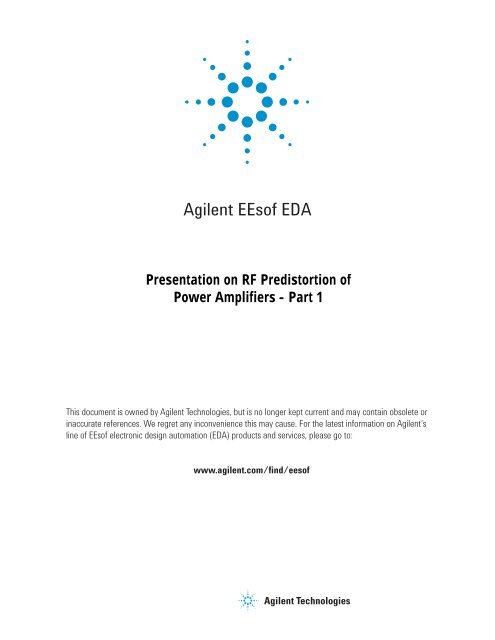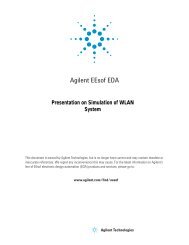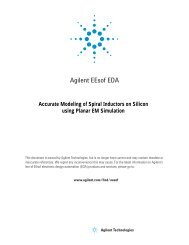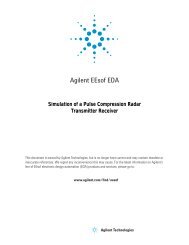Presentation on RF Predistortion of Power Amplifiers - Agilent ...
Presentation on RF Predistortion of Power Amplifiers - Agilent ...
Presentation on RF Predistortion of Power Amplifiers - Agilent ...
You also want an ePaper? Increase the reach of your titles
YUMPU automatically turns print PDFs into web optimized ePapers that Google loves.
<strong>Agilent</strong> EEs<strong>of</strong> EDA<br />
This document is owned by <strong>Agilent</strong> Technologies, but is no l<strong>on</strong>ger kept current and may c<strong>on</strong>tain obsolete or<br />
inaccurate references. We regret any inc<strong>on</strong>venience this may cause. For the latest informati<strong>on</strong> <strong>on</strong> <strong>Agilent</strong>’s<br />
line <strong>of</strong> EEs<strong>of</strong> electr<strong>on</strong>ic design automati<strong>on</strong> (EDA) products and services, please go to:<br />
www.agilent.com/find/ees<strong>of</strong>
Seminar: Gain Without Pain<br />
November 2000<br />
<strong>RF</strong> Predistorti<strong>on</strong> <strong>of</strong> <strong>Power</strong> <strong>Amplifiers</strong><br />
Shawn Staplet<strong>on</strong><br />
<strong>Agilent</strong> Technologies<br />
1400 Fountaingrove Parkway<br />
Santa Rosa, CA 95403
Abstract<br />
With the advent <strong>of</strong> linear modulati<strong>on</strong> methods, linearizati<strong>on</strong> <strong>of</strong> power amplifiers has become an<br />
important technology. The adaptive work functi<strong>on</strong> predistorter is an approach to optimizing<br />
out-<strong>of</strong>-band intermodulati<strong>on</strong> performance. This technique can adapt to changes in the power<br />
amplifier’s characteristics, including effects such as temperature changes, channel switching,<br />
power supply variati<strong>on</strong>, and transistor degradati<strong>on</strong>. The technique can also handle larger<br />
bandwidths than current DSP-based digital predistorters.<br />
Biography<br />
Dr. Shawn P. Staplet<strong>on</strong> has 17 years <strong>of</strong> experience in the design <strong>of</strong> <strong>RF</strong> and microwave circuits<br />
and systems. He is presently pr<strong>of</strong>essor <strong>of</strong> electrical engineering at Sim<strong>on</strong> Fraser University as<br />
well as a c<strong>on</strong>sultant for <strong>Agilent</strong> EEs<strong>of</strong>. He has developed GaAs MMIC comp<strong>on</strong>ents, including<br />
mixers, amplifiers, frequency dividers and oscillators. His most recent work includes digital<br />
signal processing, mobile communicati<strong>on</strong>s and <strong>RF</strong>/microwave systems.
Agenda & Topics<br />
<strong>RF</strong> Predistorti<strong>on</strong> <strong>of</strong> <strong>Power</strong> <strong>Amplifiers</strong><br />
• Introducti<strong>on</strong> to Adaptive <strong>RF</strong> Predistorti<strong>on</strong><br />
• Key Features: <strong>RF</strong> Predistorti<strong>on</strong> Techniques & C<strong>on</strong>cepts<br />
• <strong>RF</strong> Predistorti<strong>on</strong> Design Example<br />
• C<strong>on</strong>clusi<strong>on</strong><br />
3<br />
This secti<strong>on</strong> <strong>of</strong> the workshop provides an introducti<strong>on</strong> to predistorti<strong>on</strong>. We will cover key<br />
features, technologies, and performance issues. Approaches to solving some <strong>of</strong> the design<br />
challenges will also be presented. An adaptive work functi<strong>on</strong> based predistorter is<br />
dem<strong>on</strong>strated using the <strong>Agilent</strong> Advanced Design System. Additi<strong>on</strong>al reference<br />
informati<strong>on</strong> is also available.
Technology Overview<br />
Linearizati<strong>on</strong> approaches:<br />
• FeedForward Linearizati<strong>on</strong><br />
– Based <strong>on</strong> inherently wideband technology<br />
• Digital Predistorti<strong>on</strong><br />
– Limited Bandwidth (DSP implementati<strong>on</strong>)<br />
• Cartesian Feedback<br />
– Stability c<strong>on</strong>siderati<strong>on</strong>s limit bandwidth and accuracy<br />
• LINC<br />
– Sensitive to comp<strong>on</strong>ent drift and has a high level <strong>of</strong> complexity<br />
• Dynamic Biasing<br />
– Limited ACI suppressi<strong>on</strong><br />
• <strong>RF</strong>-Based Predistorti<strong>on</strong><br />
– Limited accuracy <strong>of</strong> functi<strong>on</strong> model<br />
– Implemented at <strong>RF</strong> with low complexity<br />
– Adaptati<strong>on</strong> is required<br />
4<br />
Of the various linearizati<strong>on</strong> techniques that have been developed, predistorti<strong>on</strong> is the<br />
most comm<strong>on</strong>ly used. The c<strong>on</strong>cept behind predistorti<strong>on</strong> calls for the inserti<strong>on</strong> <strong>of</strong> a<br />
n<strong>on</strong>linear module between the input signal and the power amplifier. The n<strong>on</strong>linear<br />
module generates IM distorti<strong>on</strong> that is in anti-phase with the IM distorti<strong>on</strong> produced by<br />
the power amplifier, thereby reducing out-<strong>of</strong>-band emissi<strong>on</strong>s.<br />
The <strong>RF</strong>-based predistorter has two distinct advantages over other approaches. First, the<br />
correcti<strong>on</strong> is applied before the power amplifier where inserti<strong>on</strong> loss is less critical.<br />
Sec<strong>on</strong>d, the correcti<strong>on</strong> architecture has a moderate bandwidth.<br />
Digital predistorti<strong>on</strong> technique are more complex, but provide better IM distorti<strong>on</strong><br />
suppressi<strong>on</strong>. However, bandwidths are low due to limited DSP computati<strong>on</strong>al rates.<br />
Cartesian feedback are relatively less complex and <strong>of</strong>fers reas<strong>on</strong>able IM distorti<strong>on</strong><br />
suppressi<strong>on</strong>, but stability c<strong>on</strong>siderati<strong>on</strong>s limit the bandwidth to a few hundred KHz.<br />
The LINC technique c<strong>on</strong>verts the input signal into two c<strong>on</strong>stant envelope signals that are<br />
amplified by Class C amplifiers, and then combined, before transmissi<strong>on</strong>. C<strong>on</strong>sequently,<br />
they are very sensitive to comp<strong>on</strong>ent drift.<br />
Dynamic biasing is similar to predistorti<strong>on</strong>, however the work functi<strong>on</strong> operates <strong>on</strong> the<br />
power amplifier’s operating bias.<br />
Feedforward linearizati<strong>on</strong> is the <strong>on</strong>ly strategy that simultaneously <strong>of</strong>fers wide bandwidth<br />
and good IM distorti<strong>on</strong> suppressi<strong>on</strong>. The price for this performance is higher complexity.<br />
Automatic adaptati<strong>on</strong> is essential to maintain performance.
<strong>RF</strong>-Based Predistorti<strong>on</strong><br />
<strong>Power</strong> Amplifier<br />
<strong>RF</strong> input<br />
Delay<br />
Complex Gain<br />
Adjuster<br />
<strong>RF</strong> Output<br />
I<br />
Q<br />
Envelope Detector<br />
Work Functi<strong>on</strong><br />
or Look-up<br />
Table<br />
Out <strong>of</strong> Band<br />
Filter<br />
DSP<br />
Optimizati<strong>on</strong> <strong>of</strong><br />
Parameters<br />
<strong>Power</strong> Detector<br />
5<br />
The linearizer creates a predistorted versi<strong>on</strong> <strong>of</strong> the desired modulati<strong>on</strong>. The predistorter<br />
c<strong>on</strong>sists <strong>of</strong> a complex gain adjuster that c<strong>on</strong>trols the amplitude and phase <strong>of</strong> the input<br />
signal. The amount <strong>of</strong> predistorti<strong>on</strong> is c<strong>on</strong>trolled by two n<strong>on</strong>linear work functi<strong>on</strong>s that<br />
interpolate the AM/AM and AM/PM n<strong>on</strong>linearities <strong>of</strong> the power amplifier.<br />
Note that the envelope <strong>of</strong> the input signal is an input to the work functi<strong>on</strong>s. The feedback<br />
path samples a porti<strong>on</strong> <strong>of</strong> the undesired spectrum. The work functi<strong>on</strong> parameters are<br />
then adjusted by the DSP to minimize the undesired signal. The undesired signal is<br />
typically the adjacent channel power.
Spectrum at the Nodes<br />
<strong>RF</strong> input<br />
Delay<br />
Complex Gain<br />
Adjuster<br />
I<br />
Q<br />
<strong>Power</strong> Amplifier<br />
<strong>RF</strong> Output<br />
Envelope Detector<br />
Work Functi<strong>on</strong><br />
or Look-up<br />
Table<br />
Out <strong>of</strong> Band<br />
Filter<br />
DSP<br />
Optimizati<strong>on</strong> <strong>of</strong><br />
Parameters<br />
<strong>Power</strong> Detector<br />
6<br />
Given a two-t<strong>on</strong>e input signal, we can observe the spectral resp<strong>on</strong>se at various nodes in<br />
the <strong>RF</strong> predistorter. The functi<strong>on</strong> <strong>of</strong> the envelope detector is to extract the amplitude<br />
modulati<strong>on</strong> <strong>of</strong> the input <strong>RF</strong> signal. The delay line in the upper branch compensates for the<br />
time delay added as the envelope passes through the work functi<strong>on</strong>. The complex gain<br />
adjuster, <strong>on</strong>ce optimized, provides the inverse n<strong>on</strong>linear characteristics to those <strong>of</strong> the<br />
power amplifier. Thus, we can observe the spectral growth from the predistorter at the<br />
input node <strong>of</strong> the power amplifier. Ideally the IM products will be equal in amplitude, but<br />
anti-phase the IM products created as the two t<strong>on</strong>es pass through the power amplifier.<br />
The out-<strong>of</strong>-band filter samples the adjacent power interference (ACPI). The functi<strong>on</strong> <strong>of</strong><br />
the DSP is to slowly adapt the work functi<strong>on</strong> parameters so that the ACPI is minimized.
Design Techniques<br />
<strong>RF</strong>-Based Predistorti<strong>on</strong><br />
• Generic <strong>RF</strong> predistorti<strong>on</strong> techniques<br />
– Work functi<strong>on</strong> (I.e. polynomial, exp<strong>on</strong>ential)<br />
– Look-up table<br />
– Analog n<strong>on</strong>linearity (I.e. Diodes)<br />
• Generic adaptati<strong>on</strong> techniques...<br />
– ACI power minimizati<strong>on</strong><br />
– Gradient evaluati<strong>on</strong><br />
7<br />
In the mid-’80s and early ’90s, many patents were filed covering adaptive predistorti<strong>on</strong>.<br />
These patents encompass two general adaptati<strong>on</strong> methods—adaptati<strong>on</strong> based <strong>on</strong> power<br />
minimizati<strong>on</strong> and adaptati<strong>on</strong> based <strong>on</strong> gradient signals.<br />
The c<strong>on</strong>trol scheme for power-minimizati<strong>on</strong> adaptati<strong>on</strong> is based <strong>on</strong> trying to adjust the<br />
complex gain adjuster to minimize the measured power <strong>of</strong> the error signal in the out-<strong>of</strong>band<br />
frequency. Once the optimum parameters have been achieved, deliberate<br />
perturbati<strong>on</strong>s are required to c<strong>on</strong>tinuously update the coefficients, which reduces the<br />
effects <strong>of</strong> IM distorti<strong>on</strong> suppressi<strong>on</strong>.<br />
Adaptati<strong>on</strong> based <strong>on</strong> the use <strong>of</strong> gradient signals requires a c<strong>on</strong>tinuous computati<strong>on</strong> to<br />
estimate the gradient <strong>of</strong> a three-dimensi<strong>on</strong>al power surface. The surface for the <strong>RF</strong><br />
predistorter circuit is the difference between the input signal and the scaled output signal.<br />
This power is minimized when the error signal is completely suppressed. Since the<br />
gradient is c<strong>on</strong>tinually updated, no deliberate misadjustment is required.<br />
There are three distinct <strong>RF</strong> predistorti<strong>on</strong> techniques.<br />
The work functi<strong>on</strong>-based approach utilizes a low-order polynomial to fit the AM/AM and<br />
AM/PM characteristics <strong>of</strong> the power amplifier.<br />
The look-up table technique fits the power amplifier’s characteristics more accurately.<br />
However, it requires a more sophisticated adaptati<strong>on</strong> technique.<br />
The analog n<strong>on</strong>linearity technique uses diodes to generate IM distorti<strong>on</strong>. This IM<br />
distoriti<strong>on</strong> is then phased and attenuated to make it anti-phase with the distorti<strong>on</strong> created<br />
by the power amplifier.
Rectangular Work Functi<strong>on</strong> Predistorter<br />
<strong>Power</strong> Amplifier<br />
Rectangular Gain Functi<strong>on</strong><br />
F(ρ) ) = F 1 (ρ)) + j • F 2 (ρ)<br />
F 1 (ρ)) = (1+G 1 • ρ+G<br />
2 • ρ 2 )<br />
F 2 (ρ)) = (1+P 1 • ρ+P<br />
2 • ρ 2 )<br />
ρ is squared envelope<br />
<strong>RF</strong> input Delay<br />
Envelope Detector<br />
From DSP<br />
G1<br />
I<br />
Complex Gain<br />
Adjuster<br />
I<br />
Q<br />
Work Functi<strong>on</strong><br />
or Look-up<br />
Table<br />
DSP<br />
Optimizati<strong>on</strong> <strong>of</strong><br />
Parameters<br />
Q<br />
<strong>RF</strong> Output<br />
Out <strong>of</strong> Band<br />
Filter<br />
<strong>Power</strong> Detector<br />
Delay<br />
G2<br />
Envelope<br />
Detector<br />
LPF<br />
ρ<br />
P1<br />
P2<br />
8<br />
The rectangular work functi<strong>on</strong> implementati<strong>on</strong> requires the use <strong>of</strong> a complex gain adjuster,<br />
which has in-phase and quadrature c<strong>on</strong>trols. The work functi<strong>on</strong> c<strong>on</strong>sists <strong>of</strong> a simple sec<strong>on</strong>dorder<br />
polynomial expressed in terms <strong>of</strong> the squared envelope. When this functi<strong>on</strong> is<br />
multiplied by the input signal in the complex gain adjuster, a fifth-order polynomial is<br />
produced which is expressed in terms <strong>of</strong> the signal envelope. There are four parameters that<br />
are slowly adapted by the DSP or microprocessor, with the ultimate goal <strong>of</strong> minimizing the<br />
adjacent channel power interference.
ACI <strong>Power</strong> Minimizati<strong>on</strong><br />
I<br />
Q<br />
<strong>RF</strong> input<br />
Delay<br />
Complex Gain<br />
Adjuster<br />
<strong>Power</strong> Amplifier<br />
<strong>RF</strong> Output<br />
D/A<br />
D/A<br />
Envelope Detector<br />
I<br />
Q<br />
Work Functi<strong>on</strong><br />
or Look-up<br />
Table<br />
Out <strong>of</strong> Band<br />
Filter<br />
DSP<br />
Optimizati<strong>on</strong> <strong>of</strong><br />
Parameters<br />
<strong>Power</strong> Detector<br />
Workfuncti<strong>on</strong><br />
Digital Signal<br />
Processing<br />
A/D<br />
<strong>Power</strong> Detector<br />
Bandpass Filter<br />
O<br />
Local Oscillator<br />
9<br />
This adaptati<strong>on</strong> c<strong>on</strong>troller is representative <strong>of</strong> the “minimum power” principle applied to<br />
<strong>RF</strong> predistorti<strong>on</strong>. The I and Q c<strong>on</strong>trol voltages are adjusted to minimize the power in port<br />
O, which is a sample <strong>of</strong> the interference created in the adjacent channel.<br />
Drawbacks to this method are slow c<strong>on</strong>vergence to minimum and sensitivity to<br />
measurement noise, especially near minimum. <strong>Power</strong> measurements are inherently noisy,<br />
therefore l<strong>on</strong>g dwell times are required at each step to reduce the variance <strong>of</strong> the<br />
measurement.<br />
Two methods have been devised to mitigate this problem. In the first, a tunable receiver<br />
is used to select a frequency band that includes <strong>on</strong>ly distorti<strong>on</strong>, and then the c<strong>on</strong>troller<br />
works to minimize this quantity. Another approach subtracts a phase- and gain-adjusted<br />
replica <strong>of</strong> the input from the output. Ideally, this leaves <strong>on</strong>ly the distorti<strong>on</strong>, which is then<br />
fed into port O and used in the minimizati<strong>on</strong> algorithm.
ADS <strong>RF</strong> Predistorti<strong>on</strong> Simulati<strong>on</strong><br />
Simulati<strong>on</strong> Parameters:<br />
1) Two-t<strong>on</strong>e modulati<strong>on</strong> (Fc(<br />
Fc=850<br />
MHz, ∆= = 1MHz)<br />
2) Fifth-order polynomial work functi<strong>on</strong><br />
3) Adjacent channel power minimizati<strong>on</strong><br />
4) Dwell time <strong>of</strong> 450 µsec per iterati<strong>on</strong><br />
5) Iterative LMS adaptati<strong>on</strong> between α 3 and α 5<br />
6) Motorola power amplifier<br />
7) Ideal passive comp<strong>on</strong>ents assumed<br />
10<br />
The Advanced Design System <strong>RF</strong> predistorter simulati<strong>on</strong> example is based <strong>on</strong> the<br />
rectangular work functi<strong>on</strong> technique. In this approach we utilize the secant method to<br />
adapt the work functi<strong>on</strong> coefficients to minimize ACPI. The four coefficients are<br />
iteratively adjusted with 450 microsec<strong>on</strong>ds <strong>of</strong> power averaging. A Motorola power<br />
amplifier is used in the cosimulati<strong>on</strong>, and the passive comp<strong>on</strong>ents, such as power splitters<br />
and combiners, are assumed to be ideal.<br />
For dem<strong>on</strong>strati<strong>on</strong> purposes, a two-t<strong>on</strong>e input centered <strong>on</strong> 850 MHz is used.
ADS <strong>RF</strong> Predistorti<strong>on</strong> Circuit<br />
Predistorter<br />
Predistorter<br />
<strong>RF</strong> <strong>RF</strong> Input Input<br />
<strong>Power</strong> <strong>Power</strong> Amplifier Amplifier<br />
<strong>RF</strong> <strong>RF</strong> Output Output<br />
ACI ACI <strong>Power</strong> <strong>Power</strong> Detector Detector<br />
LMS LMS<br />
Adaptati<strong>on</strong> Adaptati<strong>on</strong><br />
11<br />
Here is the Advanced Design System circuit schematic for the <strong>RF</strong> predistorter. The<br />
adaptati<strong>on</strong> technique is based <strong>on</strong> the power-minimizati<strong>on</strong> method. The rectangular<br />
implementati<strong>on</strong> is used for the complex gain adjuster, and the input c<strong>on</strong>sists <strong>of</strong> a two-t<strong>on</strong>e<br />
modulati<strong>on</strong>. The least-mean-squared adaptati<strong>on</strong> technique is used.
<strong>Power</strong> Amplifier used in <strong>RF</strong> Predistorter<br />
Motorola Motorola <strong>Power</strong> <strong>Power</strong> Amplifier Amplifier<br />
<strong>RF</strong> <strong>RF</strong> Input Input<br />
<strong>RF</strong> <strong>RF</strong> Output Output<br />
MOSFET MOSFET<br />
12<br />
A Motorola power amplifier is used in this example.
Coefficient values for <strong>RF</strong> Predistorter<br />
Coefficient Coefficient<br />
value value<br />
3rd 3rd Order Order Im{α}<br />
Im{α}<br />
3rd 3rd Order Order Re{α}<br />
Re{α}<br />
Time Time (us) (us)<br />
Adaptive <strong>RF</strong> Predistorter Using Rectangular Coordinate Work Functi<strong>on</strong><br />
13<br />
Notice in this adaptati<strong>on</strong> example that the real third-order coefficient is adapted first,<br />
followed by the imaginary third-order coefficient. The coefficients adapt slowly—a dwell<br />
time <strong>of</strong> 450 microsec<strong>on</strong>ds is used to obtain a stable output power measurement.<br />
Instability can occur if proper attenti<strong>on</strong> is not paid to the adaptati<strong>on</strong> procedure. The fifthorder<br />
coefficients are adapted using the same approach.
Third-Order IM Distorti<strong>on</strong> Performance<br />
dBc dBc<br />
(10dB/Div) (10dB/Div)<br />
13 13 dB dB Improvement Improvement (3rd) (3rd)<br />
Time Time (µs) (µs)<br />
Adaptive <strong>RF</strong> Predistorter Using Rectangular Coordinate Work Functi<strong>on</strong><br />
14<br />
This plot dem<strong>on</strong>strates the improvement in third-order intermodulati<strong>on</strong> levels at the<br />
output <strong>of</strong> the <strong>RF</strong> predistorter.
Two-T<strong>on</strong>e Simulati<strong>on</strong> <strong>of</strong> <strong>RF</strong> Predistorter<br />
Before<br />
Before<br />
After<br />
After<br />
IMD IMD Products<br />
Products<br />
13 13 dB dB IMD IMD Reducti<strong>on</strong><br />
Reducti<strong>on</strong><br />
Frequency Frequency (1MHz/Div)<br />
(1MHz/Div)<br />
Frequency Frequency (1MHz/Div)<br />
(1MHz/Div)<br />
Adaptive <strong>RF</strong> Predistorter Using Rectangular Coordinate Work Functi<strong>on</strong><br />
15<br />
The plot <strong>on</strong> the left reveals the effects <strong>of</strong> driving the power amplifier at 5dB back-<strong>of</strong>f.<br />
High levels <strong>of</strong> intermodulati<strong>on</strong> power and harm<strong>on</strong>ics are generated. The plot at right<br />
shows the improvement in the output from the <strong>RF</strong> predistorter <strong>on</strong>ce the coefficients have<br />
adapted. We can observe the spectral growth that occurs using a predistorter. The<br />
adjacent channel power is spread over a wider bandwidth, but mask requirements can be<br />
meet.
Summary<br />
<strong>RF</strong> Based Predistorti<strong>on</strong><br />
●<br />
Adaptive <strong>RF</strong> predistorters are moving from the<br />
research to the development phase.<br />
Design Soluti<strong>on</strong>s<br />
●<br />
●<br />
●<br />
The ADS <strong>RF</strong> predistorter design example dem<strong>on</strong>strates<br />
the performance achievable with linearizati<strong>on</strong>.<br />
System level simulati<strong>on</strong> provides a solid starting point<br />
for building an implementati<strong>on</strong> quickly.<br />
Designed comp<strong>on</strong>ents can be integrated into a system to<br />
witness the impact <strong>on</strong> overall performance.<br />
16
For more informati<strong>on</strong> about<br />
<strong>Agilent</strong> EEs<strong>of</strong> EDA, visit:<br />
www.agilent.com/find/ees<strong>of</strong><br />
<strong>Agilent</strong> Email Updates<br />
www.agilent.com/find/emailupdates<br />
Get the latest informati<strong>on</strong> <strong>on</strong> the<br />
products and applicati<strong>on</strong>s you select.<br />
<strong>Agilent</strong> Direct<br />
www.agilent.com/find/agilentdirect<br />
Quickly choose and use your test<br />
equipment soluti<strong>on</strong>s with c<strong>on</strong>fidence.<br />
www.agilent.com<br />
For more informati<strong>on</strong> <strong>on</strong> <strong>Agilent</strong> Technologies’<br />
products, applicati<strong>on</strong>s or services, please<br />
c<strong>on</strong>tact your local <strong>Agilent</strong> <strong>of</strong>fice. The<br />
complete list is available at:<br />
www.agilent.com/find/c<strong>on</strong>tactus<br />
Americas<br />
Canada (877) 894-4414<br />
Latin America 305 269 7500<br />
United States (800) 829-4444<br />
Asia Pacific<br />
Australia 1 800 629 485<br />
China 800 810 0189<br />
H<strong>on</strong>g K<strong>on</strong>g 800 938 693<br />
India 1 800 112 929<br />
Japan 0120 (421) 345<br />
Korea 080 769 0800<br />
Malaysia 1 800 888 848<br />
Singapore 1 800 375 8100<br />
Taiwan 0800 047 866<br />
Thailand 1 800 226 008<br />
Europe & Middle East<br />
Austria 0820 87 44 11<br />
Belgium 32 (0) 2 404 93 40<br />
Denmark 45 70 13 15 15<br />
Finland 358 (0) 10 855 2100<br />
France 0825 010 700*<br />
*0.125 €/minute<br />
Germany 01805 24 6333**<br />
**0.14 €/minute<br />
Ireland 1890 924 204<br />
Israel 972-3-9288-504/544<br />
Italy 39 02 92 60 8484<br />
Netherlands 31 (0) 20 547 2111<br />
Spain 34 (91) 631 3300<br />
Sweden 0200-88 22 55<br />
Switzerland 0800 80 53 53<br />
United Kingdom 44 (0) 118 9276201<br />
Other European Countries:<br />
www.agilent.com/find/c<strong>on</strong>tactus<br />
Revised: March 27, 2008<br />
Product specificati<strong>on</strong>s and descripti<strong>on</strong>s<br />
in this document subject to change<br />
without notice.<br />
© <strong>Agilent</strong> Technologies, Inc. 2008

















